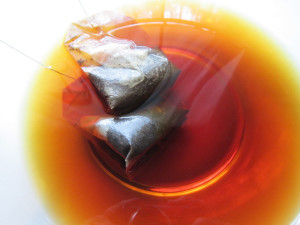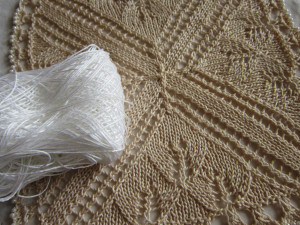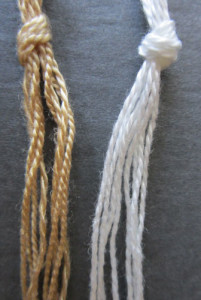The idea of featuring tea time dyeing in one of my designs has been brewing for years! I’m thrilled to finally be sharing it with you for this month’s KAL of Tea-Time Serviette.
Tea gives fibers a tan or light brown color, thus shifting a stark white into a vintage look. Tea dyeing can also be used to soften bright colors, or to harmonize a variegated thread into closer tonal values in which lace usually shows better.
Dyeing with tea is definitely not difficult. The necessary supplies are easy to get, too (i.e. tea bags, a bowl and water).
But I do want to make sure you get started in the right direction by choosing a suitable thread/yarn if you plan to dye.
Fiber Choices
The most critical step to successful tea dyeing is your thread choice. Pick one that is a non-synthetic fiber (or at least predominantly so). Non-synthetics encompass both
- natural fibers and
- those manufactured from regenerated natural fibers.
Natural fibers are a good choice for dyeing. Common examples are cotton, silk and wool. The photo here is white crochet cotton thread size 10 before and after being dyed with tea.
Regenerated natural fibers also dye well. Common examples are Tencel lyocell and rayon. This photo is natural white 5/2 Tencel before and after being dyed with tea.
Synthetic fibers are those made from petrochemicals; i.e. chemical substances obtained from petroleum or natural gas. Common examples are acrylic and polyester. These are difficult to dye without special dying agent products. Attempts to dye this type fiber with tea will result in little or no change in color.
Tip: You need not avoid threads that are partially synthetic. Just be aware that the synthetic component will resist the dye. This is likely to give the thread a tweedy or mottled look that could obscure the lace design. It’s best to take some of the unknit thread and do a test dye before potentially ruining your knitted piece.
If you have questions about what thread to use for knitting and dyeing Tea-time Serviette, give me a shout-out. I’ll do my best to help.





 HeartStrings FiberArts
HeartStrings FiberArts Knitting Bits of Lace on Facebook
Knitting Bits of Lace on Facebook Ravelry Store
Ravelry Store
Jackie – what cotton yarn would you suggest for this project? Do you sell that kind of yarn. I would like a thicker fiber than size 10. What you used in yours looks great. I just ordered from PayPal a part of the kit: Opal Ceylon beads in beige (I hope would be close to tea dye color or slightly darker), pattern. What size needles? If you do sell the fiber too, you can either invoice me or I will pay through PayPal the changed abount due. Thanks for your help, Deb in MN
I am handicapped and it is impossible to get a wheel chair into the store and the people shopping there and/or the staff get upset with my stying to traverse the store area.
Dear Deb,
I don’t know if Jackie has some yarn that would work for you, but there is a terrific online source for cotton threads! I also have mobility issues, and live in a rural area where selection is very limited when I can get to stores, and I’ve been too thrilled to be able to shop at:
http://www.herrschners.ca/ It is a great resource for so many projects and carries hundreds of colours of thread and yarn suitable for these lovely lace projects at reasonable prices. (They also have lots of fabulous sales, did three quarters of my Christmas shopping there last year, I was amazed!)
Best of luck,
Joy
Hi Deb, I’ve emailed you with suggestion. As I mentioned in my email to you (and so other people will know, too), you won’t want to go with much thicker than size 10, because you will need to get the beads onto the yarn. I’ve sent you a suggestion for an approx fingering weight cotton/rayon I have that will work with the beads and will dye lovely.
Hey Jackie,
Can an 8/2 cotton be substituted for the #10 cotton. I cannot find anywhere on the web that has that info.
Lorri
Yes, an 8/2 cotton is a good choice. It’s a little finer than size 10 crochet thread, but the sizing on this is not necessary to be exact anyway. If you can find a 5/2 cotton (which is just a bit thicker), that would be a good substitute, too. Have fun!